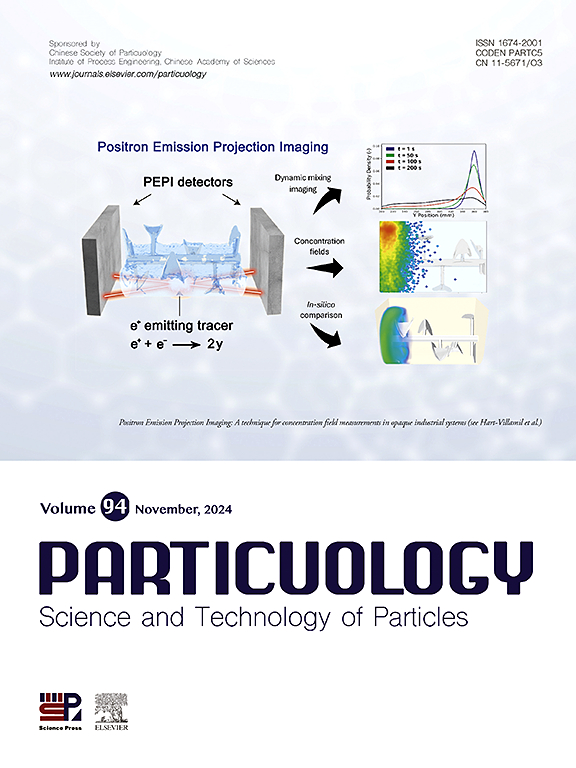Competitive effects between heterogeneous and homogeneous nucleation during particle condensation growth process
IF 4.3
2区 材料科学
Q2 ENGINEERING, CHEMICAL
引用次数: 0
Abstract
The principal method for improving the removal efficiency of fine particles emitted from coal-fired power plants involves the application of water vapor phase change pretreatment technology. This study utilizes molecular dynamic (MD) simulation to examine the heterogeneous nucleation process between fine particles and H2O under conditions of multi-gas composition. Results showed that the heterogeneous nucleation and the homogeneous nucleation process of H2O occur concurrently, with both processes engaged in a competitive relationship. The nucleation process of H2O on particles is characterized by the formation of specific sites. In these regions, H2O interacts strongly with the O atoms on the particle surface through hydrogen bonding, leading to preferential condensation in the vicinity of these sites. The influence of temperature on particle growth primarily involves interaction and self-diffusion processes of H2O. As the temperature decreases, the size of particles initially increases and then decreases, reaching a maximum at 323 K. In contrast to the effects of temperature change, the influence of H2O content on fine particulate growth is primarily characterized by the competition between homogeneous and heterogeneous nucleation of H2O molecules. These findings, including the nucleation characteristics of fine particles and the influence mechanism of gas temperature and humidity, strengthen the theoretical system of water vapor phase change technology to promote the removal of fine particles from coal-fired flue gas, and provide theoretical support for subsequent process optimization.

颗粒凝聚生长过程中非均相成核与非均相成核的竞争效应
提高燃煤电厂排放细颗粒物去除效率的主要方法是应用水蒸气相变预处理技术。本研究利用分子动力学(MD)模拟研究了多气体组成条件下细颗粒与水之间的非均相成核过程。结果表明,水的非均相成核和非均相成核过程同时发生,两者处于竞争关系。水在粒子上的成核过程以形成特定的位点为特征。在这些区域,H2O通过氢键与粒子表面的O原子发生强烈的相互作用,导致在这些位置附近优先凝结。温度对颗粒生长的影响主要涉及H2O的相互作用和自扩散过程。随着温度的降低,颗粒尺寸先增大后减小,在323 K时达到最大值。与温度变化的影响相反,H2O含量对细颗粒生长的影响主要表现为H2O分子的均质成核和非均质成核之间的竞争。这些研究结果,包括细颗粒的成核特征和气体温度、湿度的影响机理,强化了水蒸气相变技术促进燃煤烟气细颗粒去除的理论体系,为后续工艺优化提供了理论支持。
本文章由计算机程序翻译,如有差异,请以英文原文为准。
求助全文
约1分钟内获得全文
求助全文
来源期刊

Particuology
工程技术-材料科学:综合
CiteScore
6.70
自引率
2.90%
发文量
1730
审稿时长
32 days
期刊介绍:
The word ‘particuology’ was coined to parallel the discipline for the science and technology of particles.
Particuology is an interdisciplinary journal that publishes frontier research articles and critical reviews on the discovery, formulation and engineering of particulate materials, processes and systems. It especially welcomes contributions utilising advanced theoretical, modelling and measurement methods to enable the discovery and creation of new particulate materials, and the manufacturing of functional particulate-based products, such as sensors.
Papers are handled by Thematic Editors who oversee contributions from specific subject fields. These fields are classified into: Particle Synthesis and Modification; Particle Characterization and Measurement; Granular Systems and Bulk Solids Technology; Fluidization and Particle-Fluid Systems; Aerosols; and Applications of Particle Technology.
Key topics concerning the creation and processing of particulates include:
-Modelling and simulation of particle formation, collective behaviour of particles and systems for particle production over a broad spectrum of length scales
-Mining of experimental data for particle synthesis and surface properties to facilitate the creation of new materials and processes
-Particle design and preparation including controlled response and sensing functionalities in formation, delivery systems and biological systems, etc.
-Experimental and computational methods for visualization and analysis of particulate system.
These topics are broadly relevant to the production of materials, pharmaceuticals and food, and to the conversion of energy resources to fuels and protection of the environment.
 求助内容:
求助内容: 应助结果提醒方式:
应助结果提醒方式:


